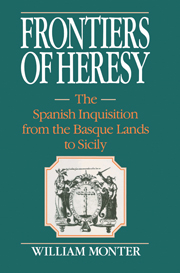Book contents
- Frontmatter
- Contents
- List of maps and figure
- List of tables
- Preface
- PART 1 THE HOLY OFFICE OUTSIDE CASTILE
- PART 2 ARAGONESE TRIBUNALS
- PART 3 ARAGONESE HERESIES
- PART 4 “MIXED CRIMES” IN ARAGON
- PART 5 RECESSIONAL
- APPENDICES
- 1 Deaths at public autos de fe in the Aragonese Secretariat, 1540–1640
- 2 Galley condemnations in the Aragonese Secretariat, 1560–1640
- 3 Executions in effigy in the Aragonese Secretariat, 1541–1640
- Glossary
- Index
- CAMBRIDGE STUDIES IN EARLY MODERN HISTORY
3 - Executions in effigy in the Aragonese Secretariat, 1541–1640
Published online by Cambridge University Press: 24 October 2009
- Frontmatter
- Contents
- List of maps and figure
- List of tables
- Preface
- PART 1 THE HOLY OFFICE OUTSIDE CASTILE
- PART 2 ARAGONESE TRIBUNALS
- PART 3 ARAGONESE HERESIES
- PART 4 “MIXED CRIMES” IN ARAGON
- PART 5 RECESSIONAL
- APPENDICES
- 1 Deaths at public autos de fe in the Aragonese Secretariat, 1540–1640
- 2 Galley condemnations in the Aragonese Secretariat, 1560–1640
- 3 Executions in effigy in the Aragonese Secretariat, 1541–1640
- Glossary
- Index
- CAMBRIDGE STUDIES IN EARLY MODERN HISTORY
Summary
This book has deliberately paid little attention to the people whom the Spanish Inquisition executed in effigy rather than in person, concentrating instead on the most severe physical punishments inflicted on live prisoners. In the sixteenth century as in the twentieth, it made a great deal of difference to the spectators whether people or statues were being burned after a public auto. From the prisoner's point of view, it was far better to learn from a safe distance that you had been executed in effigy than to be sent to the galleys. But from the spectator's point of view, watching an effigy burn provided an extremely satisfying catharsis, far better than watching chained prisoners straggling away to the galleys, leaving their sanbenitos at the water's edge. From the king's point of view, imposing galley sentences was a great public service, but burning effigies (except that of Antonio Pérez) was simply an administrative expense. In the Crown of Aragon after 1540, virtually no one was executed in effigy for financial reasons; the vast majority of these victims were penniless.
- Type
- Chapter
- Information
- Frontiers of HeresyThe Spanish Inquisition from the Basque Lands to Sicily, pp. 331 - 333Publisher: Cambridge University PressPrint publication year: 1990

